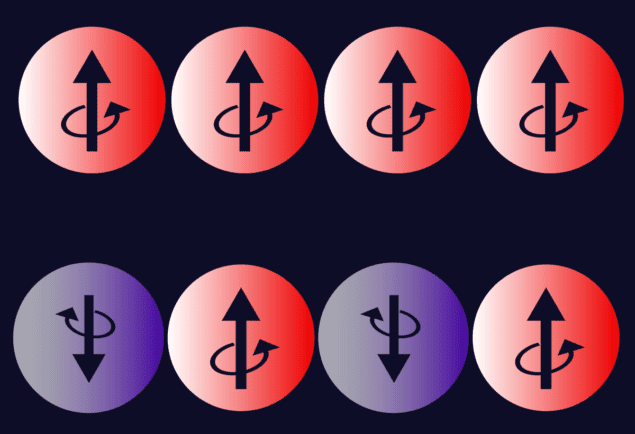
Physicists in the US have shown that rotating matter at high speeds can magnetize atomic nuclei – 104 years after physicist Samuel Barnett showed the same could be done with electrons. The researchers found that by spinning a small sample of water at thousands of revolutions a second inside a nuclear magnetic resonance device, they could increase the magnetization of hydrogen nuclei by up to about 3%. The result has been touted as the first-ever observation of the nuclear Barnett effect, however, a scientist in Japan points-out that similar work was done there in 2014.
The idea that an object’s rotation and magnetization are coupled was first predicted by Owen Richardson in 1908. He reasoned that the angular momenta of electrons in an unconfined and uncharged object placed in a magnetic field would tend to line up along the axis of magnetization. Electrons would therefore rotate around that axis, with conservation of momentum then dictating that the object’s bulk turns in the opposite direction.
Albert Einstein and Wander Johannes de Haas observed this effect seven years later by suspending a ferromagnetic rod inside a cylindrical coil that set up a magnetic field along the rod’s axis. They found that when they switched on the current in the coil the rod started to rotate, so demonstrating that magnetism is in fact due to the combined magnetic moment of orbiting electrons. In a curious twist, the angular momentum they recorded agreed with theory at the time, but was later shown to be twice as big as it should have been once electron spin was factored in.
Correct value
At the same time, however, Barnett demonstrated the opposite effect. He showed in a long series of experiments that a freely-hanging ferromagnetic rod is magnetized when rotated along its axis at high speeds. What is more, the magnitude of the effect that he measured was close to the correct value, even though it seemed wrong at the time.
Now, Tycho Sleator and Mohsen Arabgol at New York University have measured this “Barnett effect” in nuclei, rather than electrons. Doing so is more difficult because protons and neutrons are far heavier than electrons, meaning they have far smaller magnetic moments.
The duo used nuclear magnetic resonance (NMR), which subjects a sample to a strong magnetic field to align the spins of certain nuclei – in this case protons (hydrogen nuclei) within water. The proton spins can exist in one of two energy states, and when exposed to electromagnetic pulses with just the right frequency some proton spins will flip to the higher energy state. After each pulse, protons return to the lower energy state and precess around the magnetic field lines as they do so. This modulates the magnetic field at the precession frequency and this signal is detected in a receiving coil. The basic idea of this latest experiment is to rotate a sample of water at high speed inside an NMR machine and measure the extent to which the proton spins are aligned, or polarized, by being rotated — after accounting for the effect of the machine’s magnetic field.
Spin cycle
The researchers originally intended to exploit the effect in brain imaging, by shining X-rays with orbital angular momentum at a person’s head to rotate water molecules and so enhance the output signal. That was not a success, but the duo discovered they could buy commercial high-speed spinning devices and so opted instead to rotate samples of molecules mechanically.
“We stumbled on this and realized we might be able to do the experiment by spinning the sample,” says Sleator. “And it seemed like no one had done that before.”

Optical centrifuge magnetizes molecular gas
They put water inside a capsule 8 mm long and 2 mm in diameter. This was placed within the commercial spinner, which was then put inside an NMR device. They set the spinner rotating at different rates and measured how proton polarization varied as a result. If the protons really were being polarized by sample rotation, then the NMR signal – which is proportional to the magnetization and precession frequency – should have risen in line with the spin rate.
Theory predicts that there should be a 1% rise in magnetization at 4500 revolutions per second (rps), a 2% increase at 9000 rps, and a 3% jump at 13,500 rps. And that, within experimental error, was what they observed. They also confirmed that the higher magnetization was not due to any real magnetic field being set up inside the sample, since they saw no rise in the precession frequency, which is proportional to magnetic field strength.
Writing in Physical Review Letters, Arabgol and Sleator say, “We have made the first observation of the nuclear Barnett effect”. However, one researcher who wishes to remain anonymous questions just how novel the latest research is. In 2014 a group at the Japan Atomic Energy Agency reported observing “emergent Barnett fields” by rotating an NMR coil together with various powdered solids at high speeds. “Nuclear magnetization is proportional to magnetic fields,” says one of the group members, “and, for me, these two findings convey almost the same message”.



